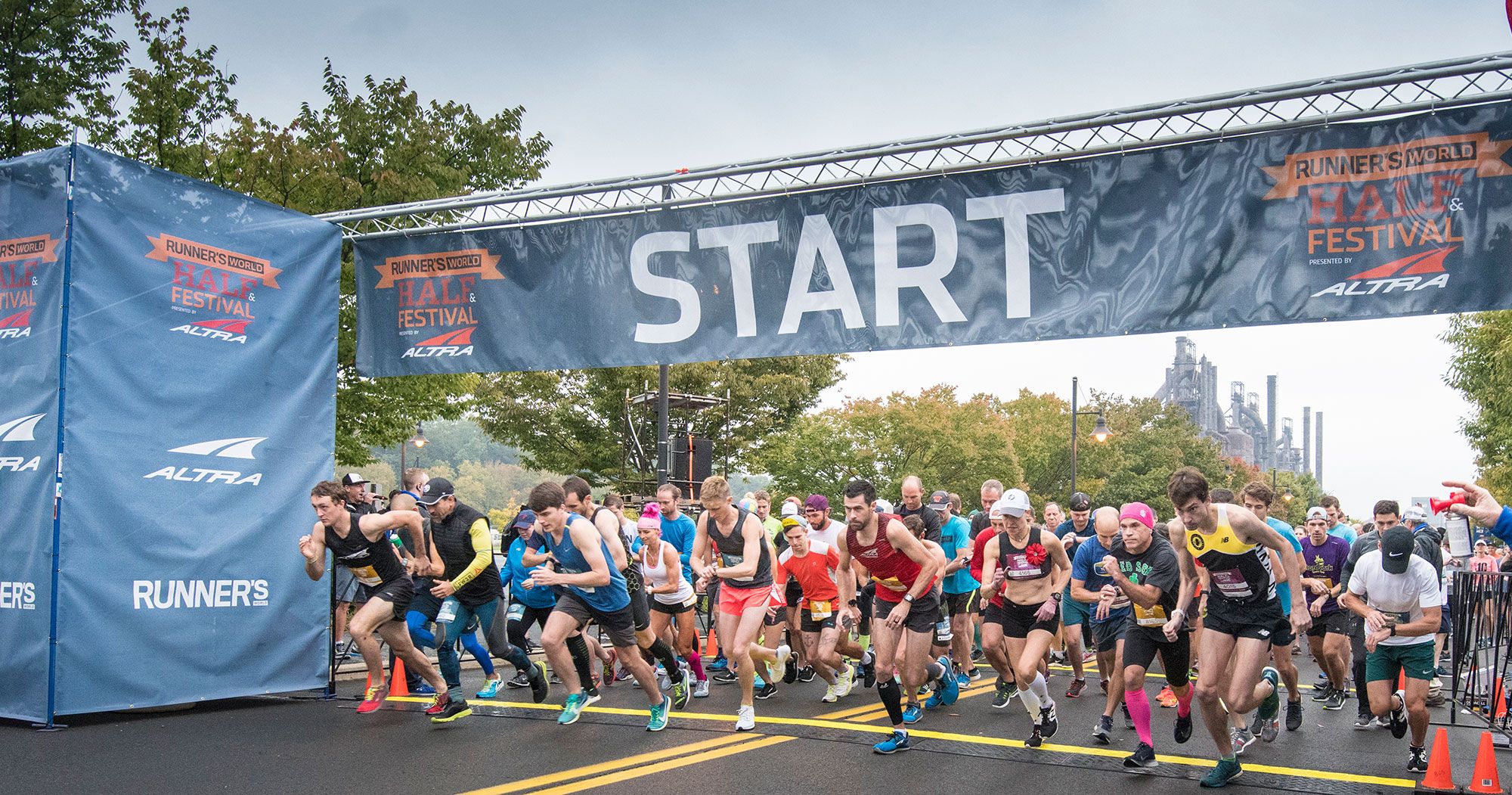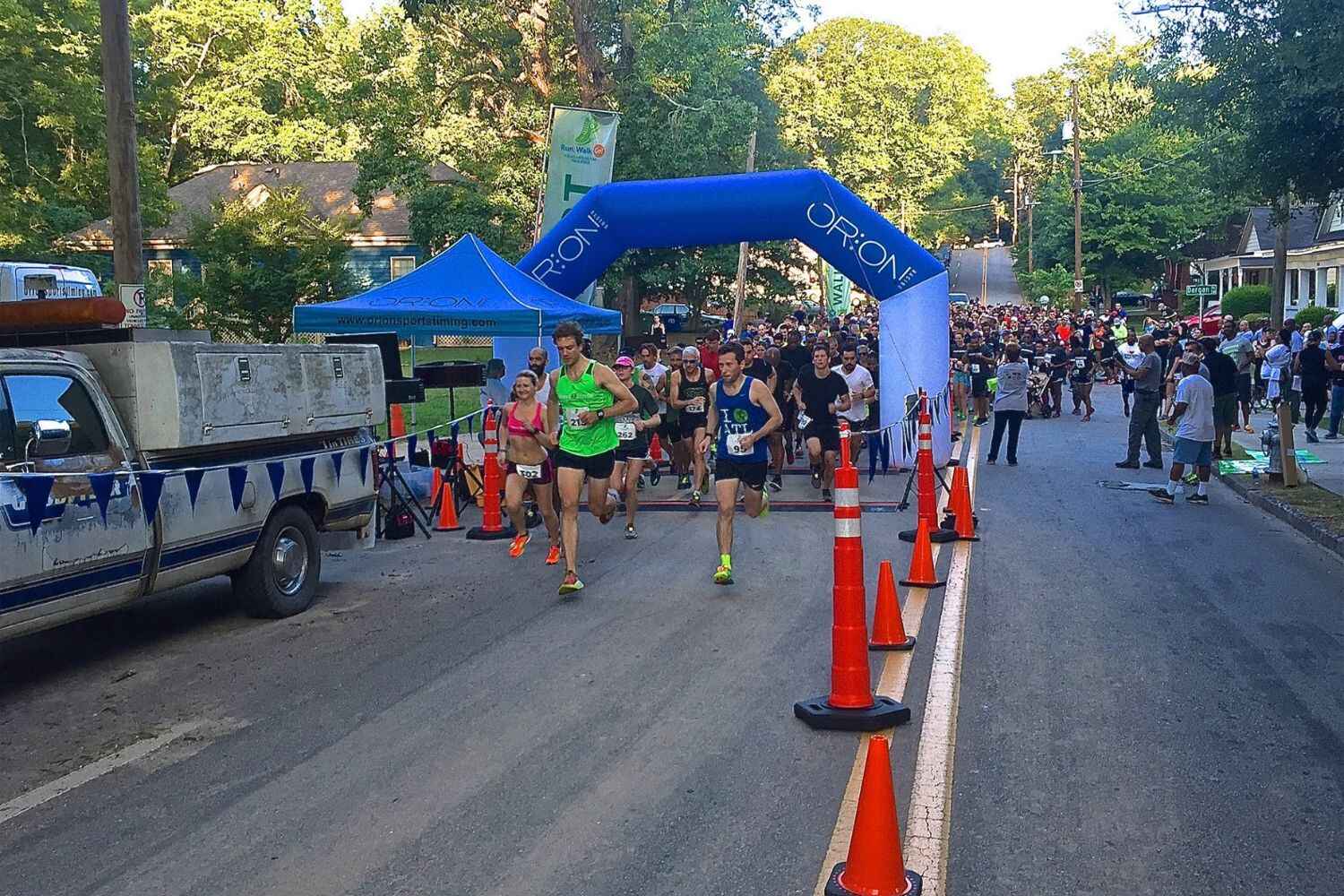

Featured
How To Hold A Virtual 5K Run
Published: August 29, 2023
Looking to host a virtual 5K run? Our featured guide will show you how to plan and execute a successful event, bringing the community together for a fun and active experience.
Introduction
Welcome to the world of virtual 5K runs – a new, exciting way to participate in a running event from the comfort of your own neighborhood or even your own treadmill. Whether you are an experienced runner looking for a unique challenge or a novice looking to step into the running community, a virtual 5K run is a fantastic option to consider.
The concept of a virtual 5K run has gained immense popularity in recent times, especially with the global pandemic restricting traditional in-person races. It allows participants to complete the distance of 5 kilometers at their own pace, in their preferred location, and at a time that suits them best. You can run, jog, or walk the distance – the choice is entirely up to you!
Not only does a virtual 5K run provide the flexibility and freedom to participate from anywhere in the world, but it also eliminates logistical constraints such as travel arrangements, accommodation, and time commitment. It opens doors for anyone, regardless of their physical location or busy schedule, to be a part of the running community and experience the thrill of completing a 5K race.
Participating in a virtual 5K run offers numerous benefits beyond just physical exercise. It provides an opportunity to connect with like-minded individuals, join a supportive community, and contribute to a cause you care about. Additionally, virtual races allow participants to set personal goals, track their progress, and challenge themselves to improve their fitness and performance.
Organizing a virtual 5K run can be just as rewarding as participating in one. It allows race organizers to reach a broader audience, engage participants from different parts of the world, and create a unique event experience. Moreover, virtual races often provide a platform for fundraising and charitable initiatives, making them an excellent opportunity to make a positive impact on the community.
In this article, we will explore the various aspects of organizing a virtual 5K run, from choosing a platform and promoting the event to distributing runner’s kits and engaging participants. We will also discuss safety tips and highlight the charitable aspects of virtual races. So, get ready to lace up your shoes, join the virtual running movement, and embark on an exciting 5K journey!
Choosing a Platform for Virtual 5K Run
When it comes to organizing a virtual 5K run, selecting the right platform is crucial. The platform you choose will determine how participants register, track their runs, and engage with the event. Here are some key factors to consider when choosing a platform:
- User-Friendly Interface: Look for a platform that is easy to navigate and user-friendly. Participants should be able to register, submit their race times, and access event information without any technical difficulties.
- Registration and Payment Options: The platform should offer a seamless registration process with secure payment options. It should allow participants to enter their personal details, select their preferred registration package, and make payment without any hassle.
- Tracking Capabilities: Ensure that the platform has a reliable tracking system that allows participants to record and submit their race times. It can be in the form of a mobile app, website feature, or integration with popular fitness tracking devices.
- Event Information and Communication: Look for a platform that allows organizers to provide detailed event information such as date, time, route suggestions, and any additional instructions. It should also have communication tools to send updates and announcements to participants.
- Engagement Features: Consider a platform that offers interactive features to keep participants engaged. This can include leaderboards, virtual badges, social media integration, and the ability to share progress and photos with the virtual community.
- Data Management and Privacy: Prioritize a platform that prioritizes data security and privacy. It should have measures in place to protect participants’ personal information and comply with data regulations.
There are several popular platforms available that cater specifically to virtual races. Some examples include Virtual Strides, Racery, RunSignup, and Race Roster. Take some time to explore and compare the features, pricing, and customer reviews of these platforms to find the one that aligns best with your event goals and budget.
Remember, choosing the right platform is essential to ensure a smooth and enjoyable experience for both organizers and participants. Take the time to research and make an informed decision that will set the foundation for a successful virtual 5K run.
Setting a Date and Time for the Run
When organizing a virtual 5K run, selecting the perfect date and time is essential to ensure maximum participation and create a sense of camaraderie among participants. Here are some factors to consider when setting the date and time for your virtual event:
- Research and Avoid Conflicts: Check the calendar for any major holidays, local events, or other virtual races happening around the same time. Avoid scheduling your event on dates that may draw potential participants away or cause conflicts.
- Consider Time Zones: If your event attracts participants from different time zones, it’s important to choose a time that accommodates the majority of participants. Consider a time slot that is convenient for participants across different regions.
- Weekend vs. Weekday: Weekends are generally more popular for virtual events as participants tend to have more time to take part. However, hosting your event on a weekday can make your race stand out and attract participants looking for a mid-week challenge.
- Weather Conditions: If your virtual event requires participants to run outdoors, take into account the typical weather conditions during the chosen date. Avoid extreme weather conditions that may discourage participation or compromise safety.
- Race Duration: Consider the duration of your virtual 5K run. Some events are organized as a single-day event, while others allow participants to complete the distance over a period of several days or weeks. Decide if your virtual race will have a specific time frame or if participants have the flexibility to choose their own timing within a given time window.
- Theme or Cause: If your virtual 5K run is aligned with a specific theme or cause, try to select a date that holds significance to the theme or cause. For example, organizing a charity run on a day that marks an important awareness day can help generate more interest and participation.
Once you have considered these factors, select a date and time that best suits your event goals and target audience. It’s a good idea to announce the date well in advance to allow participants ample time to prepare and adjust their schedules accordingly.
Remember to communicate the date and time clearly on your event website, registration page, and through various marketing channels. Provide participants with any specific instructions regarding time zone conversions, any time restrictions, or time frame flexibility for completing the virtual 5K run.
By carefully selecting the date and time for your virtual 5K run, you can ensure that participants have a positive and memorable experience, leading to greater engagement and enjoyment throughout the event.
Designing and Promoting the Event
Designing and promoting your virtual 5K run is crucial to attract participants, build excitement, and create a buzz around your event. Here are some key steps to design and effectively promote your virtual 5K run:
- Create a Compelling Event Website: Design a visually appealing and informative event website. Include key details such as event date, registration information, race rules, frequently asked questions, and a countdown timer to build anticipation.
- Craft an Engaging Event Description: Write a compelling event description that captures the essence of your virtual 5K run. Highlight the unique aspects, such as a scenic route suggestion or a charitable cause associated with the event.
- Utilize Social Media Platforms: Leverage social media platforms like Facebook, Instagram, and Twitter to create buzz around your event. Share visually appealing graphics, videos, and engaging content to attract potential participants.
- Create Eye-Catching Graphics: Design eye-catching graphics that showcase your event logo, brand, and theme. These graphics can be used on the event website, social media posts, and promotional materials.
- Collaborate with Influencers: Partner with fitness influencers, local athletes, or running enthusiasts to promote your virtual 5K run. Their endorsement and participation can significantly boost visibility and credibility for your event.
- Run Giveaways and Contests: Organize giveaways and contests on social media platforms to engage your audience and encourage participation. Offer prizes such as event merchandise, discount codes, or free registrations to attract more participants.
- Tap into Running Communities: Reach out to local running clubs, online forums, and fitness communities to spread the word about your virtual 5K run. Offer special group discounts or incentives for them to participate and promote the event among their network.
- Email Marketing Campaign: Build an email list of interested participants and regularly send updates and reminders about your event. Use email marketing tools to design visually appealing newsletters and include important information, such as registration deadlines and exclusive offers.
- Engage Previous Participants: If you have previously organized virtual runs, reach out to past participants and offer them exclusive discounts or incentives to join your upcoming event. Their positive experiences can encourage them to join again and share their enthusiasm with others.
- Local Media Outreach: Contact local newspapers, radio stations, or online blogs to create a press release or news article about your virtual 5K run. Highlight the unique aspects, the cause you are supporting, and any notable participants or special circumstances surrounding the event.
Remember to track the effectiveness of your promotional efforts using tools like Google Analytics or social media insights. This will help you identify which marketing channels are generating the most engagement and adjust your strategy accordingly.
By designing an appealing event website, utilizing social media platforms, collaborating with influencers, and implementing a strategic marketing plan, you can effectively promote your virtual 5K run and attract a diverse range of participants.
Registration Process and Fees
The registration process for your virtual 5K run should be seamless and user-friendly. Providing participants with a simple and efficient way to register for your event will help ensure a high participation rate. Here are some key considerations for setting up the registration process:
- Online Registration: Set up an online registration system that allows participants to easily sign up for your virtual 5K run. This can be done through your event website or by utilizing a dedicated registration platform.
- Registration Form: Create a registration form that collects all necessary participant information, such as name, age, contact details, and t-shirt size (if applicable). Keep the form concise and user-friendly to encourage completion.
- Registration Packages: Offer different registration packages to cater to different participant preferences. This can include options for a basic registration, a registration with a runner’s kit, or a premium package that includes additional swag.
- Discounts and Incentives: Provide early bird discounts or promotional codes to incentivize participants to sign up early. You can also offer group discounts for team registrations or special discounts for certain demographics, such as students or healthcare workers.
- Secure Payment Gateway: Ensure that your registration system has a secure payment gateway to process participant fees. Choose a trusted payment processor that offers secure and reliable transaction processing.
- Optional Fundraising: If your virtual 5K run is associated with a charitable cause, consider providing participants with the option to raise additional funds through their registration. This can be done by integrating a fundraising platform into the registration process.
- Confirmation and Communication: Once participants have registered, send them a confirmation email with their registration details and any necessary next steps. Regularly communicate with registered participants through email or a dedicated participant portal to provide event updates or send reminders.
When determining the registration fee for your virtual 5K run, consider the cost of organizing the event, including any swag or runner’s kits provided to participants. It is important to strike a balance between affordability for participants and ensuring that the event remains financially viable. Research similar virtual races to get an idea of the registration fees charged by other organizers.
Remember to clearly communicate what participants can expect in terms of race perks, such as t-shirts, medals, digital certificates, or any other swag. Highlight the value they will receive for their registration fee to encourage sign-ups.
Offer participants a flexible and convenient payment method, such as credit card payments or popular online payment platforms like PayPal or Stripe. This will make the registration process smooth and efficient for participants.
By implementing a user-friendly registration process and setting appropriate fees, you can attract a wide range of participants to your virtual 5K run and ensure a positive experience for everyone involved.
Sending Runners’ Kits and Swag
One of the exciting aspects of a virtual 5K run is the opportunity to provide runners with a memorable experience through the distribution of runners’ kits and swag. These items not only serve as incentives for participants but also help create a sense of unity and pride among the virtual running community. Here are some key considerations for sending out runners’ kits and swag:
- Runner’s Kit Contents: Design and curate a runner’s kit that includes essential items for participants. This can include a race bib, t-shirt, finisher medal or certificate, and any additional promotional items or sponsor gifts.
- Quality and Design: Ensure that the items in the runner’s kit are of high quality and visually appealing. The t-shirt should be comfortable and feature an attractive design that participants would proudly wear during their virtual 5K run.
- Personalization: Consider adding personalization to the runner’s kit, such as including participants’ names on the race bib or sending a personalized note to each participant. This adds a special touch and makes participants feel valued.
- Swag and Extras: Enhance the participant experience by including additional swag or extras in the runner’s kit. This can include items like stickers, wristbands, water bottles, energy bars, or discounts for future events.
- Shipping and Delivery: Choose a reliable shipping service that can deliver the runner’s kits to participants in a timely manner. Provide participants with tracking information so they can anticipate the arrival of their kits.
- International Participants: If your virtual 5K run attracts participants from around the world, consider the logistics and additional costs associated with shipping internationally. Clearly communicate any additional fees or shipping restrictions to international participants.
- Virtual Swag Bag: In addition to physical items, consider creating a virtual swag bag that participants can access digitally. This can include exclusive offers, digital coupons, or downloadable resources related to fitness, wellness, or sponsor-related content.
- Communication: Regularly communicate with participants regarding the status of their runner’s kits. Send confirmation emails upon registration, provide updates on the shipping process, and address any inquiries or concerns promptly.
When planning the distribution of runners’ kits and swag, it is important to consider the cost, logistical challenges, and delivery timelines. Research shipping options, negotiate bulk shipping rates if applicable, and ensure that participants receive their kits well in advance of the virtual 5K run date.
By sending out runners’ kits and swag, you not only provide participants with tangible rewards for their participation but also create a memorable and immersive experience that enhances their virtual 5K run journey.
Encouraging Participants to Track Their Run
Tracking participants’ runs is an important aspect of a virtual 5K run. It allows participants to measure their progress, compare their results with others, and provide a sense of accomplishment. Here are some strategies to encourage participants to track their run:
- Provide Tracking Options: Offer multiple tracking options to accommodate different preferences. This can include using a dedicated race tracking app, integrating with popular fitness tracking devices, or manually submitting run times on the event website.
- Clear Instructions: Provide participants with clear and concise instructions on how to track their run. Explain which tracking method they should use, how to sync their devices (if applicable), and how to submit their results within the specified timeframe.
- Engagement and Support: Create a virtual community and engage participants throughout their virtual 5K journey. Encourage participants to share their progress, photos, and experiences on social media using a dedicated event hashtag. Respond to their posts, celebrate milestones, and provide words of encouragement.
- Leaderboards: Implement leaderboards on your event website or through a tracking platform to showcase participants’ times and rankings. This fosters healthy competition and motivates participants to improve their performance.
- Virtual Milestones: Celebrate participants’ achievements by recognizing virtual milestones. This can include sending digital badges or certificates for completing certain distances, such as a halfway point or a full 5K run.
- Virtual Challenges: Organize virtual challenges to keep participants engaged and motivated. This can include weekly mileage challenges, fastest mile competitions, or themed challenges that tie into your event’s theme or cause.
- Reward System: Establish a reward system to incentivize participants to track their runs. This can include offering virtual tokens or points for each tracked run, which participants can accumulate towards unlocking exclusive rewards or entering prize drawings.
- Participant Spotlights: Feature participants on your event website or social media platforms. Share their stories, training routines, or reasons for participating to inspire others and create a sense of connection within the virtual running community.
- Final Results Celebration: Wrap up your virtual 5K run by celebrating participants’ achievements with a final results announcement. Highlight notable performances and offer prizes or recognition for top finishers in different categories.
Communication plays a crucial role in encouraging participants to track their runs. Regularly remind participants about the tracking process, deadline, and any technical support available. Send out weekly or bi-weekly email updates to keep them informed and motivated.
By implementing these strategies and actively engaging participants, you can encourage them to track their runs, foster a sense of community and competition, and ultimately enhance the participant experience in your virtual 5K run.
Creating Virtual Community and Engagement
Building a virtual community and fostering engagement among participants is key to creating a memorable and enjoyable experience in a virtual 5K run. Here are some strategies to establish a sense of community and encourage engagement:
- Create a Dedicated Online Space: Establish a dedicated online space, such as a Facebook group or forum, where participants can connect, share their experiences, and support one another. Encourage active participation and moderate the space to ensure a positive and inclusive environment.
- Use Event Hashtags: Choose a unique event hashtag and encourage participants to use it when posting on social media. This allows them to connect with others who are also participating in the virtual 5K run and provides a way to easily discover and engage with their posts.
- Weekly Challenges and Activities: Organize weekly challenges or activities that participants can take part in. This could include theme-based photo contests, workout challenges, or virtual scavenger hunts. These activities foster engagement and create a sense of camaraderie.
- Encourage Social Sharing: Encourage participants to share their training progress, photos, and thoughts about the virtual 5K run on social media. Acknowledge their posts, comment, and share their content to show appreciation and highlight their efforts.
- Virtual Meetups and Group Runs: Organize virtual meetups or group runs where participants can connect through video conferencing platforms. This provides an opportunity for participants to meet face-to-face, share their experiences, and cheer each other on.
- Highlight Participant Stories: Share participant stories or testimonials on your event website, social media platforms, or email newsletters. Highlight their accomplishments, personal motivations, and challenges they have overcome. This creates a sense of inspiration and builds a stronger community bond.
- Host Live Q&A Sessions: Organize live Q&A sessions with expert guests or experienced runners in your virtual 5K run community. Participants can submit questions in advance or ask them during the session, providing a platform for learning and sharing knowledge.
- Encourage Peer Support: Foster a supportive environment where participants can offer encouragement and support to one another. Create opportunities for participants to share tips, advice, and strategies for training, staying motivated, or overcoming obstacles.
- Showcase Sponsors or Partners: Recognize the contributions of your sponsors or partners by highlighting their involvement in your virtual 5K run. Provide opportunities for sponsors to engage with participants through promotions, giveaways, or interactive activities.
- Offer Virtual Training Sessions: Provide virtual training sessions led by experienced coaches or trainers. These sessions can focus on various aspects of running, such as proper warm-up and cool-down exercises, injury prevention, or nutrition tips.
Regularly communicate with participants through email newsletters or announcements to keep them informed about upcoming activities, challenges, and engagement opportunities. Actively respond to participant inquiries and encourage open communication.
By implementing these strategies and fostering a strong virtual community, you can create a supportive and engaging environment that enhances the overall experience of your virtual 5K run.
Organizing a Virtual Awards Ceremony
An awards ceremony is a great way to acknowledge and celebrate the accomplishments of participants in your virtual 5K run. While the traditional in-person ceremony may not be possible in a virtual setting, you can still create a memorable and engaging virtual awards ceremony. Here are some steps to consider when organizing a virtual awards ceremony:
- Define the Categories: Determine the different award categories for your virtual 5K run. This can include overall winners, age group winners, fastest male and female participants, best costume, most improved runner, or any other creative categories you wish to include.
- Announcement and Recognition: Plan how you will announce the winners and recognize their achievements. This can be done through a live-streamed event, pre-recorded videos, or social media announcements. Ensure that the announcement is engaging, visually appealing, and includes a personal touch for each winner.
- Create Virtual Certificates or Digital Badges: Prepare virtual certificates or digital badges to be awarded to the winners. These can be personalized with the participant’s name, category, and event branding. Share the certificates digitally or allow winners to download and print them as a memento.
- Include Guest Speakers: Invite guest speakers, such as experienced runners, local celebrities, or representatives from charities associated with your event, to give motivational speeches or congratulate the winners. This adds excitement and a sense of prestige to the virtual awards ceremony.
- Interactive Elements: Incorporate interactive elements into the virtual awards ceremony to engage participants. This can include live chat features, polls, or mini-games. Encourage participants to actively participate and share their well wishes or congratulations in real-time.
- Create a Digital Program: Develop a digital program or agenda for the virtual awards ceremony. This can be shared with participants in advance and outline the sequence of events, special announcements, and the order of award presentations.
- Record the Ceremony: Ensure that you record the virtual awards ceremony to make it available for participants who may not be able to attend the live event. This allows them to watch the ceremony at their convenience and relive the excitement of the winners’ announcements.
- Share the Ceremony on Social Media: After the live event, share highlights or key moments from the virtual awards ceremony on social media platforms. This extends the reach of the event and allows participants to revisit and share the joy of the celebration.
- Create Prizes or Giveaways: Consider offering prizes or giveaways during the virtual awards ceremony. This can be in the form of sponsor gifts, event merchandise, or free entries to future virtual races. Conduct random drawings or trivia contests to ensure fairness in the distribution of prizes.
- Express Gratitude: Use the virtual awards ceremony as an opportunity to express gratitude to all participants, sponsors, volunteers, and anyone who contributed to the success of the virtual 5K run. Show appreciation for their support and emphasize the positive impact of their involvement.
Announce the details of the virtual awards ceremony well in advance of the event date to give participants ample time to prepare, and encourage their attendance. Provide clear instructions on how to access the ceremony and participate in any interactive elements.
By organizing an engaging and inclusive virtual awards ceremony, you can highlight the achievements of participants, create a sense of celebration, and leave a lasting impression on all who took part in your virtual 5K run.
Fundraising and Charitable Aspects
Organizing a virtual 5K run presents an excellent opportunity to integrate fundraising and support charitable causes. By incorporating a charitable aspect into your event, you can make a positive impact on the community and engage participants in a meaningful way. Here are some strategies for fundraising and incorporating charitable aspects into your virtual 5K run:
- Select a Charitable Cause: Choose a cause or organization that aligns with your event’s mission or resonates with your participants. It could be a local charity, a global initiative, or a cause related to a specific issue or group of individuals.
- Create Fundraising Goals: Set fundraising goals for your event and clearly communicate them to participants. Encourage individuals and teams to raise funds, either through their registration process or by providing additional donation options. Use tools like a dedicated fundraising page or crowdfunding platforms to streamline the process.
- Highlight the Impact: Share information about the cause and the impact that donations can make. Demonstrate how the funds raised will be utilized and the difference it can make in the lives of those in need. Tie the fundraising efforts directly to the mission and purpose of your virtual 5K run.
- Offer Incentives: Provide incentives to encourage participants to fundraise. This can include recognition on the event website or social media platforms, exclusive event merchandise for top fundraisers, or special perks such as VIP race experiences or additional race swag.
- Partner with Sponsors: Collaborate with sponsors who are interested in supporting the charitable aspect of your virtual 5K run. They can contribute additional funds, offer matching donation programs, or provide resources to promote the fundraising efforts.
- Charity Challenges: Organize additional challenges or events within your virtual 5K run to specifically raise funds for the chosen charity. This can include virtual auctions, raffles, or pledge-based challenges where participants gather sponsors for specific tasks or achievements.
- onate a Portion of Registration Fees: Consider donating a percentage of the registration fees to the charitable cause. Communicate this commitment to participants and emphasize how their participation in the virtual 5K run directly supports the cause.
- Partnerships with Local Businesses: Collaborate with local businesses to create fundraising opportunities. This can include donation matching programs, hosting fundraising events or sales, or offering discounts to participants who make a donation to the chosen charity.
- Transparency and Accountability: Be transparent about the donation process and share updates on the fundraising progress with participants. Provide proof of the funds raised and how they are being utilized to create trust and credibility.
- Express Gratitude: Show appreciation to participants, sponsors, and donors for their support. Send thank-you notes, showcase their contributions on your event website or social media, and communicate the impact their donations have made.
Clearly communicate the charitable aspects of your virtual 5K run during the registration process, on your event website, and through regular updates. Highlight the collective effort of all participants in working towards a common cause.
By incorporating fundraising and charitable aspects into your virtual 5K run, you can create a meaningful experience that goes beyond the race itself, making a positive difference in the lives of others.
Safety Tips for Virtual 5K Runners
While participating in a virtual 5K run offers flexibility and convenience, it’s important to prioritize safety to ensure an enjoyable and injury-free experience. Here are some essential safety tips to keep in mind:
- Warm-Up and Cool-Down: Prior to starting your virtual 5K run, perform a thorough warm-up session to prepare your muscles and joints. After completing the run, cool down with gentle stretches to promote recovery and prevent muscle soreness.
- Choose a Safe Route: Select a safe running route that is well lit, free of hazards, and familiar to you. Avoid busy roads or areas with heavy traffic. If running outdoors, consider using sidewalks or running in parks or other designated running areas.
- Be Visible: When running outdoors, wear brightly colored or reflective clothing to ensure better visibility to motorists and other pedestrians. If running in low light or at night, use a headlamp or carry a flashlight to improve visibility.
- Stay Hydrated: Drink plenty of water before, during, and after your virtual 5K run, especially in warm weather. Carry a water bottle with you during your run or plan your route near water fountains or locations where you can refill.
- Use Proper Running Shoes: Choose running shoes that provide adequate support, cushioning, and a proper fit. This will minimize the risk of discomfort or injury during your virtual 5K run. Replace worn-out shoes to maintain proper foot alignment and shock absorption.
- Listen to Your Body: Pay attention to any pain, discomfort, or unusual sensations during your run. If you experience any issues, such as chest pain, dizziness, or shortness of breath, stop running and seek medical attention if necessary.
- Follow Physical Distancing Guidelines: Adhere to local health guidelines and maintain physical distance from others while running. Avoid crowded areas and patiently wait for enough space to safely pass other runners or pedestrians.
- Carry Identification: Carry some form of identification, such as an ID card or an emergency contact bracelet, in case of any unforeseen incidents or emergencies. Include essential medical information, such as allergies or existing conditions.
- Stay Updated on Weather Conditions: Check the weather forecast before heading out for your virtual 5K run. Be prepared for changes in weather, such as rain or heat, and make adjustments to your clothing or route accordingly.
- Practice Good Running Technique: Maintain proper running form, such as an upright posture and a relaxed stride. Focus on breathing rhythmically and avoid overstriding, which can put excessive stress on your joints.
Remember, the safety of participants is of utmost importance. Encourage participants to prioritize their well-being and to adjust their virtual 5K run plans if they are feeling unwell or experiencing any health concerns.
By following these safety tips, virtual 5K runners can ensure that their experience is not only enjoyable but also free from potential risks or injuries.
Conclusion
Organizing and participating in a virtual 5K run offers a unique and exciting opportunity to engage with a wide range of runners from all around the world. While virtual races have risen in popularity due to the constraints of in-person events, they have proven to be a fantastic alternative that provides flexibility, inclusivity, and the ability to connect with a global running community.
Throughout this article, we have explored various aspects of organizing a virtual 5K run, from choosing the right platform and promoting the event to distributing runners’ kits, encouraging participants to track their runs, and fostering a virtual community. We have also highlighted the importance of incorporating fundraising and charitable aspects, as well as prioritizing safety for all participants.
By following the recommended strategies and tips, event organizers can create a memorable and engaging virtual 5K run that offers a sense of achievement, community, and support. Participants can enjoy the flexibility to complete the 5K distance at their own pace, in their preferred location, while also contributing to a cause they care about and connecting with fellow runners virtually.
Remember, successful virtual 5K runs require careful planning, effective promotion, and seamless execution. Prioritize the needs and expectations of participants, engage with the virtual community, and be adaptable to the ever-changing landscape of virtual events.
So, lace up your running shoes, embrace the virtual running movement, and embark on an exciting journey of organizing or participating in a virtual 5K run. Together, we can bring the thrill of the race to any location, inspire and support one another, and make a positive impact on individuals and communities!









